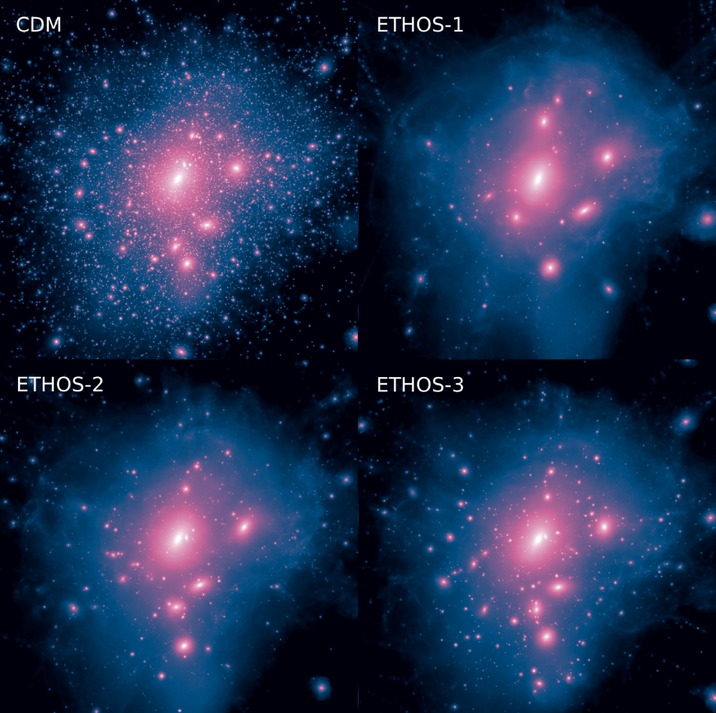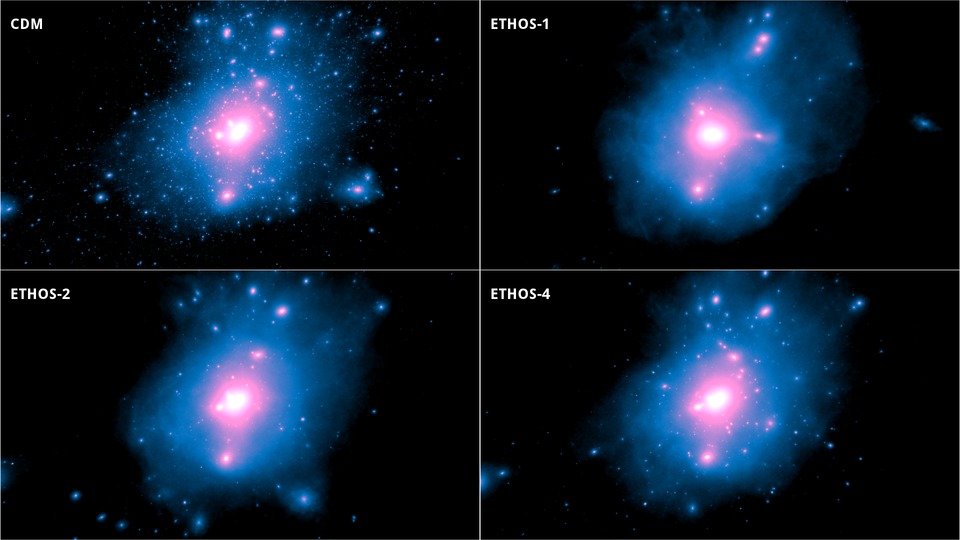ETHOS - An Effective Theory of Structure Formation
The ETHOS project provides a framework to map different dark matter models into effective structure formation models.

Paper I: From Dark particle physics to the matter distribution of the Universe
Francis-Yan Cyr-Racine, Kris Sigurdson, Jesus Zavala, Torsten Bringmann, Mark Vogelsberger, and Christoph Pfrommer:We formulate an effective theory of structure formation (ETHOS) that enables cosmological structure formation to be computed in almost any microphysical model of dark matter physics. This framework maps the detailed microphysical theories of particle dark matter interactions into the physical effective parameters that shape the linear matter power spectrum and the self-interaction transfer cross section of non-relativistic dark matter. These are the input to structure formation simulations, which follow the evolution of the cosmological and galactic dark matter distributions. Models with similar effective parameters in ETHOS but with different dark particle physics would nevertheless result in similar dark matter distributions. We present a general method to map an ultraviolet complete or effective field theory of low energy dark matter physics into parameters that affect the linear matter power spectrum and carry out this mapping for several representa- tive particle models. We further propose a simple but useful choice for characterizing the dark matter self-interaction transfer cross section that parametrizes self-scattering in structure formation simulations. Taken together, these effective parameters in ETHOS allow the classification of dark matter theories according to their structure formation properties rather than their intrinsic particle properties, paving the way for future simulations to span the space of viable dark matter physics relevant for structure formation.
Paper II: Dark matter physics as a possible explanation of the small-scale CDM problems
Mark Vogelsberger, Jesus Zavala, Francis-Yan Cyr-Racine, Christoph Pfrommer, Torsten Bringmann, and Kris Sigurdson:We present the first simulations within an effective theory of structure formation (ETHOS), which includes the effect of interactions between dark matter and dark radiation on the linear initial power spectrum and dark matter self-interactions during non-linear structure formation. We simulate a Milky Way-like halo in four different dark matter models in addition to the cold dark matter case. Our highest resolution simulation has a particle mass of 2.8 × 10 4 M and a softening length of 72.4 pc. We demonstrate that all alternative models have only a negligible impact on large scale structure formation and behave on those scales like cold dark matter. On galactic scales, however, the models significantly affect the structure and abundance of subhaloes due to the combined effects of small scale primordial damping in the power spectrum and the late time self-interaction rate in the center of subhaloes. We derive an analytic mapping from the primordial damping scale in the power spectrum to the cutoff scale in the halo mass function and the kinetic decoupling temperature. We demonstrate that it is possible to find models within this extended effective framework that can alleviate the too-big-to-fail and missing satellite problems simultaneously, and possibly the core-cusp problem. Furthermore, the primordial power spectrum cutoff of our models naturally creates a diversity in the circular velocity profiles of haloes, which is larger than that found for cold dark matter simulations. We also show that the parameter space of models can be constrained by contrasting model predictions to astrophysical observations. For example, some of our models may be challenged by the missing satellite problem if baryonic processes were to be included and even over-solve the too-big-to-fail problem; thus ruling them out.
